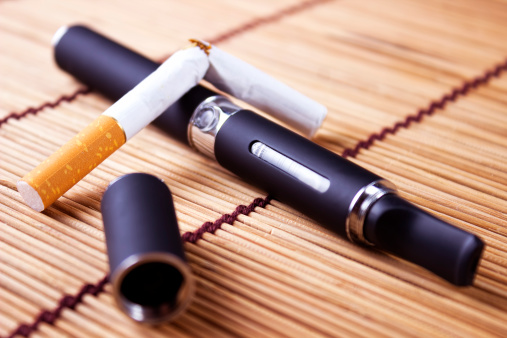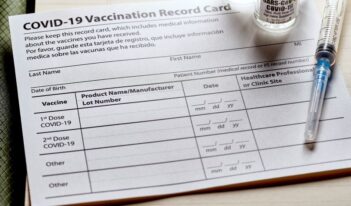
The FDA recently proposed a rule on e-cigarettes, but critics claim key protections are still needed.
Prior to the federal government’s adoption of cigarette advertising restrictions, tobacco companies used catchy slogans and advertisements to entice consumers, marketing their products as symbols of coolness. Now, e-cigarette companies are taking note of those same marketing strategies.
You might today turn on the television to find e-cigarette commercials during cable programs. Or you might open a magazine to find a glossy ad featuring a celebrity “vaping,” another term for smoking an e-cigarette. These same advertising tactics proved remarkably successful when employed years ago by cigarette companies. In particular, they helped persuade many young people to take up smoking.
You might today turn on the television to find e-cigarette commercials during cable programs. Or you might open a magazine to find a glossy ad featuring a celebrity “vaping,” another term for smoking an e-cigarette. These same advertising tactics proved remarkably successful when employed years ago by cigarette companies. In particular, they helped persuade many young people to take up smoking.
Conventional cigarette companies are now highly regulated, and thus they are prohibited from running television commercials. Meanwhile, the much newer e-cigarette industry, which has rapidly grown into a nearly $2 billion dollar industry, is not yet regulated at all.
That will likely change, as the Food and Drug Administration (FDA) issued a proposed rule earlier this year that would bring the burgeoning e-cigarette industry under its regulatory purview. The proposed rule would define e-cigarettes – as well as hookahs, cigars, and other tobacco products – as part of the tobacco industry, extending the FDA’s authority under the Family Smoking Prevention and Tobacco Control Act of 2009.
The proposed regulation includes plans for a federal minimum age limit of 18 years for e-cigarettes, requirements for e-cigarette companies to register with the FDA and receive the agency’s approval to sell new products, and an obligation that e-cigarette companies scientifically prove any health benefits they wish to claim for their products.
The FDA has received over 37,000 comments on the proposed rules, including many from public health organizations, scientists, and private citizens. While many commentators have welcomed the proposal, some have criticized what they see as several key weaknesses.
The Center for Tobacco Control Research and Education, for example, points out that restrictions on flavored nicotine products and marketing strategies – both of which disproportionately target young people – are notably absent from the FDA’s proposal. The Center argues that stronger rules are needed to prevent highly susceptible youths from becoming the next generation of nicotine addicts from their exposure to e-cigarettes.
In a recent article published in the Journal of the American Medical Association, health law experts Lawrence O. Gostin and Aliza Y. Glasner of Georgetown University highlighted other fears about gaps in the proposed rule. While e-cigarette companies have claimed that their products are safer alternatives to conventional cigarettes, Gostin and Glasner suggest that e-cigarettes may just as easily serve as a “gateway to smoking” for current non-smokers.“
Child-friendly flavors and slick promotions might encourage young people to experiment with vaping and potentially increase smoking rates among youth,” Gostin and Glasner assert. This is particularly concerning, they argue, because e-cigarettes do not carry the same “negative social stigma” that helps discourage young people from smoking conventional cigarettes.
Stigma or no stigma, the rate of young e-cigarette users has seen a near-meteoric rise. The Centers for Disease Control and Prevention has estimated that nearly 10% of middle and high school students in 2012 reported having tried using e-cigarettes at least once, more than double the figure from 2011. That amount is unlikely to decrease with e-cigarette commercials now airing on cable television and with flavors like bubble gum and banana split becoming available.
Advocacy groups like the Campaign for Tobacco Free Kids are calling for the agency to revise its proposed rule to include advertising restrictions, citing the 256% increase in youth exposure to e-cigarettes advertising via television. Like Gostin and Glasner, they argue that regulations that fail to reign in e-cigarette companies from targeting youth with ads and overly sweet flavors will be unsuccessful at reducing youth e-cigarette use.
Representative Rosa DeLauro (D-CT) has also voiced her concern in a letter to FDA Commissioner Dr. Margaret Hamburg. DeLauro welcomes the FDA proposed rule as a positive step overall, but asserts the need to “move quickly to ban child-friendly flavorings and youth-oriented marketing practices.”
Concerned parties on either side of the issue will likely have to wait a while before they get an answer on how the FDA will proceed. The FDA has extended the public comment period until August 8, 2014, and it has announced no schedule for promulgating a final rule.
In the meantime, anti-smoking activists continue to hope that e-cigarette companies do not erode decades of efforts to make smoking taboo by drawing in young people with enticing ads and flavors. The precise health risks of e-cigarettes are still under study, but health advocates are quite clear on at least one point: no nicotine addiction is better than some nicotine addiction, regardless of how a person indulges.



